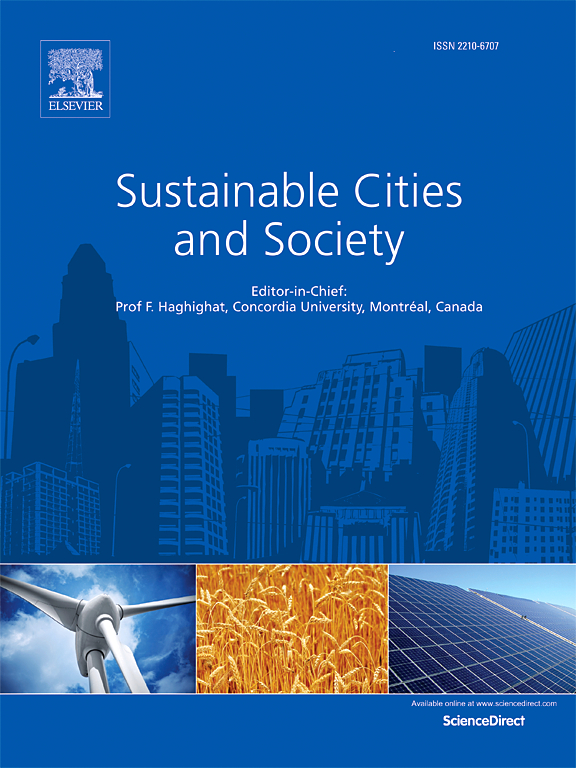IF 10.5
1区 工程技术
Q1 CONSTRUCTION & BUILDING TECHNOLOGY
引用次数: 0
摘要
街区是城市碳排放精细化管理的基本单位,也是应用低碳概念和技术的最佳场所。然而,在这一层面准确计算碳排放量仍是一项挑战,使得确定有效的去碳化战略变得更加复杂。本研究以沈阳市中心城区为例,提出利用街区层面的城市土地利用作为去碳化单元,通过整合多源数据,测算不同行业的碳排放特征。然后,根据土地的碳排放强度,建立去碳化基线,并据此衡量去碳化效果。结果显示,在沈阳市中心城区,90.99% 的二氧化碳排放来自建筑和交通部门,碳汇仅能抵消其中的 2.20%。商业用地的单位面积碳排放总量最高,而工业用地的人均碳排放量最高。此外,碳排放量在各部门之间的空间分布也严重失衡。通过基于基线指标的分级去碳化战略,实现了碳排放 19.79% 的总体去碳化。本研究介绍了一个数据驱动模型,该模型有可能应用于其他地区。本文章由计算机程序翻译,如有差异,请以英文原文为准。
Data-driven neighborhood-level carbon emission accounting models and decarbonization strategies: Empirical study on Central Shenyang City
Neighborhood is the basic unit for fine-grained management of urban carbon emissions and the best place to apply low-carbon concepts and technologies. However, accurately calculating carbon emissions at this level remains a challenge, complicating the identification of effective decarbonization strategies. This research proposes utilizing urban land use at the neighborhood level as a decarbonization unit and taking Central Shenyang City as an example to measure the carbon emission characteristics of different sectors by integrating multi-source data. Then, based on the carbon emission intensity of the lands, establishing a baseline for decarbonization and measuring its effectiveness accordingly. The results show that in Central Shenyang City, 90.99 % of CO2 emissions come from the building and transportation sectors, with carbon sinks offsetting a mere 2.20 % of these emissions. Commercial land has the highest overall level of carbon emissions per unit area, while industrial land records the highest per capita carbon emissions. In addition, there is a significant imbalance in the spatial distribution of carbon emissions among various sectors. Through a graded decarbonization strategy based on the baseline indicators, an overall decarbonization of 19.79 % in carbon emissions is achieved. This study introduces a data-driven model with potential applications in other regions.
求助全文
通过发布文献求助,成功后即可免费获取论文全文。
去求助
来源期刊

Sustainable Cities and Society
Social Sciences-Geography, Planning and Development
CiteScore
22.00
自引率
13.70%
发文量
810
审稿时长
27 days
期刊介绍:
Sustainable Cities and Society (SCS) is an international journal that focuses on fundamental and applied research to promote environmentally sustainable and socially resilient cities. The journal welcomes cross-cutting, multi-disciplinary research in various areas, including:
1. Smart cities and resilient environments;
2. Alternative/clean energy sources, energy distribution, distributed energy generation, and energy demand reduction/management;
3. Monitoring and improving air quality in built environment and cities (e.g., healthy built environment and air quality management);
4. Energy efficient, low/zero carbon, and green buildings/communities;
5. Climate change mitigation and adaptation in urban environments;
6. Green infrastructure and BMPs;
7. Environmental Footprint accounting and management;
8. Urban agriculture and forestry;
9. ICT, smart grid and intelligent infrastructure;
10. Urban design/planning, regulations, legislation, certification, economics, and policy;
11. Social aspects, impacts and resiliency of cities;
12. Behavior monitoring, analysis and change within urban communities;
13. Health monitoring and improvement;
14. Nexus issues related to sustainable cities and societies;
15. Smart city governance;
16. Decision Support Systems for trade-off and uncertainty analysis for improved management of cities and society;
17. Big data, machine learning, and artificial intelligence applications and case studies;
18. Critical infrastructure protection, including security, privacy, forensics, and reliability issues of cyber-physical systems.
19. Water footprint reduction and urban water distribution, harvesting, treatment, reuse and management;
20. Waste reduction and recycling;
21. Wastewater collection, treatment and recycling;
22. Smart, clean and healthy transportation systems and infrastructure;
 求助内容:
求助内容: 应助结果提醒方式:
应助结果提醒方式:


